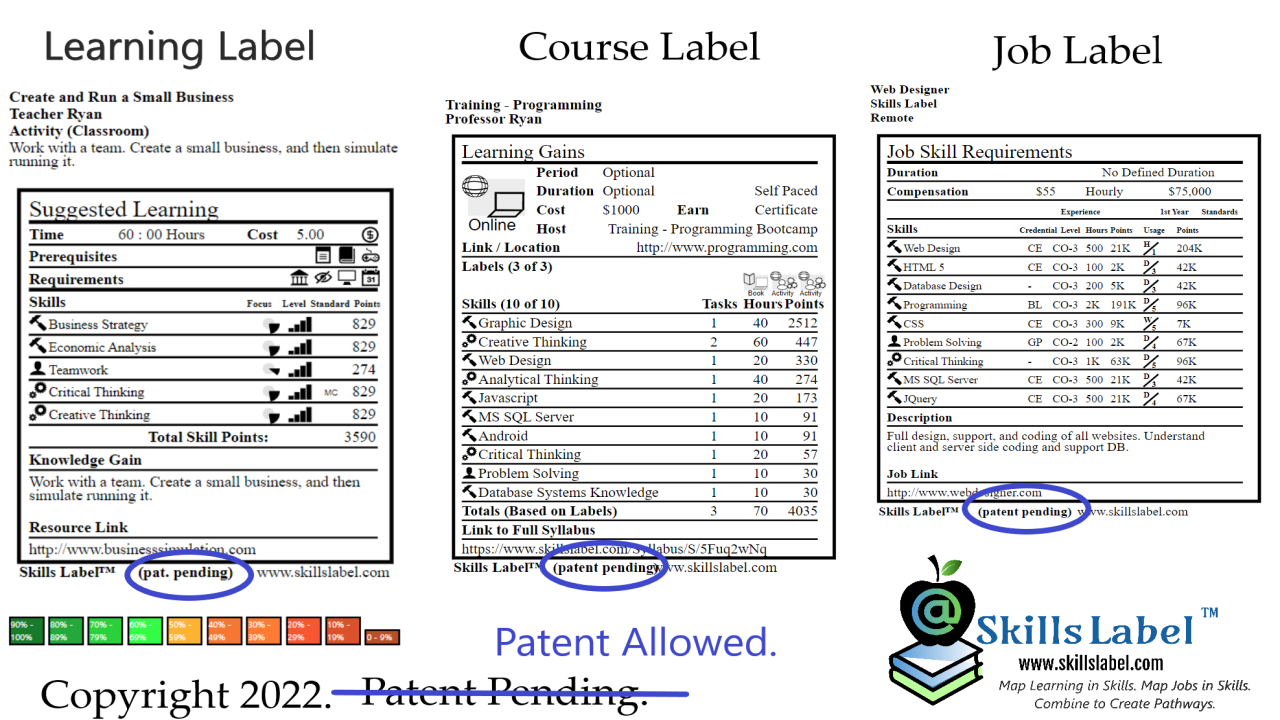Promoting learning, course and job labels (aka Skills Labels) for more than five years, essentially after all the patent applications were filed (as soon as I could). There are two important aspects to them I promote:
- Standard representation of learning expectations and job requirements.
- Skills and Skill Points are the focal point in the definitions.
For the first point, awareness is critical. I am always striking conversations telling people what the learning labels are and how they work. My usual ‘ice-breaker’, particularly with a stranger, is the ‘nutritional label’ example. Personally, I know the analogy is super simplistic (try to limit this analogy when speaking with a learning practitioner). Guess I figure the goal for the learning labels is to be read and understood by the general populace.
As I say and often repeat, learning labels solve a problem of communicating learning expectations in clear, concise way. Labels are highly readable while fitting precisely on a smartphone – no need to scroll up-down or left-right. I cannot think of how to put more on the screen – there is no room. The labels are highly interactive; there are layers and depth to them – like pop-ups showing learning standards.
Establishing the standard representation was a necessary first step. Proven worthy, the next step was to get them accessible on different screens and platforms. Now they render in native Android and Windows 10 apps and a substantial web application.
Five years before the learning labels, I started working in skills – my initial application was to get them to appear on a personal website or what I called a multi-dimensional resume. With the learning labels, for the second point, I suggest we define and quantify learning (and jobs) in skills.
My central argument is skills are knowledge, at least the action part of it, rather than a competing complement to knowledge. To get practitioners to create the labels, the goal is to get them to believe in skills in this way.
I prove this works by mapping many recent common education and higher education standards to skills into learning labels applications. The process was quite smooth.
The entrance of other skill platforms proves this is being accepted in practice. There are open-source skill databases and parsers, competency-based programs, education point systems, etc. Our recently patent allowed learning labels system proves our precedence.
On the jobs side, where skills are already commonly accepted and utilized, connect the job requirements / experience to learning expectations using skills. This only strengthens the argument to define learning in skills. Why use more than one nomenclature or classification?
With the basis of the representation in place and skills established as the medium, the final step is continual refinement:
The calculation of Skill Points should involve a complicated algorithm. (I argue on par with many of the larger ones being built today – like a search engine.) Let me provide basic context. Two commonly accepted notions (not rooted in science): takes 10,000 hours to master a skill; and takes 20 hours to learn a skill for your own needs. Personally, I do not think this makes much sense for much more than a rough guide.
In our algorithm, a suggested input is skill growth rates on a skill-by-skill basis. This would consequently provide not only a clearer interpretation on how long it takes to learn a skill, but also a more accurate measure of learning gains.
There is also room for improvement with the icons and graphics on the labels. There is space allotted for the icons and some simple icons already in place. With designers, both the icons and graphics should get much better.
My team is glad our patent applications are allowed, but there is a lot of work ahead. Contact us if you are interested in the research or design or how to index your resources with learning, course, and job labels.
